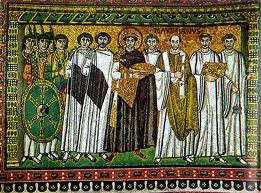|
In the Early Byzantine period, Byzantium's educated elite used Roman law, and Greek and Roman culture, to maintain a highly organized government centered on the court and its great cities. Constantinople was located on the European shore of the Bosporus, midway between the Aegean and Black seas, in what is now the country of Turkey.
The city brought together people from the lands of Europe and Asia. In AD 330 the Roman emperor Constantine I, in an attempt to strengthen the empire, re-founded Byzantium as Constantinople, the "New Rome" and capital of the eastern half of the empire. At his death in 395 Emperor Theodosius I divided the empire between his two sons, and it was never reunited.

On the death of Constantine, in AD 337, the empire is divided between his sons Constantine II, Constantius II and Constans. The sons inherit the parts of the empire which they have already ruled, on behalf of their father, as Caesars. Constantius II, though not the eldest, has the lion's share - Greece, Constantinople and the entire eastern empire. His elder brother, Constantine II, has Spain, Gaul and Britain. The youngest, Constans, controls Italy and Spain.
Leo was also the first emperor to receive the crown not from a general or an officer, as in the Roman tradition, but from the hands of the patriarch of Constantinople. This habit became mandatory as time passed, and in the Middle Ages the religious characteristic of the coronation had totally substituted the old form. First Isaurian emperor was Tarasicodissa, who was married by Leo to his daughter Ariadne (466) and ruled as Zeno I after the death of Leo I's son, Leo II.
By the middle of the 5th Century the Roman Empire was on the verge of collapse. Its emperors were mere puppets, its armies were in chaos, and enemies were closing in on all sides. Unable to sustain itself, the West collapsed, plunging Europe into the Dark Ages. By all accounts, the East should have followed suit, and yet, unexpectedly, the Eastern emperor slipped free of his barbarian master and saved the tottering state. Join Lars Brownworth as he looks at Zeno, the unlikely savior of the Byzantine Empire.
Theodoric the Ostrogoth reined during AD 487-526. Theodoric's long reign in Italy begins with this treachery, but the murder of Odoacer proves untypical of the Ostrogothic king. His thirty-three years on the throne bring a period of calm to turbulent Italy, justifiably earning him the title Theodoric the Great.
Theodoric has the good sense to leave the administration of Italy virtually unchanged and in the hands of Romans. They are prevented from serving as soldiers, but similarly Goths may not join the bureaucracy. Though himself an Arian, Theodoric makes no attempt to interfere in Roman Catholic affairs.
|

![]()
